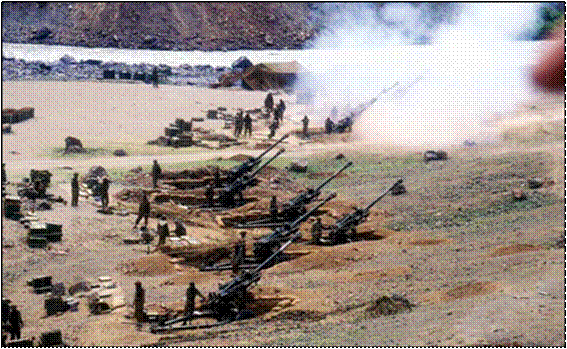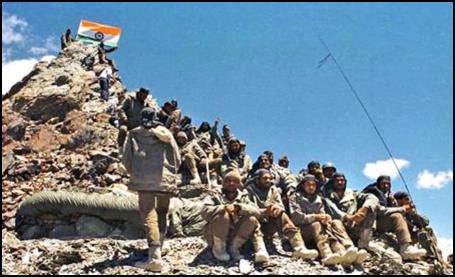Content
- Kargil Vijay Diwas 2025: Honouring 26 Years of Valour and Victory
- Power to the People: The Boom and Transformation of Cooperatives in India
Kargil Vijay Diwas 2025: Honouring 26 Years of Valour and Victory
Date Observed: 26 July 2025
Commemoration of: Victory in the 1999 Kargil War
Conflict Duration: May–July 1999
Location: Kargil Sector, Jammu & Kashmir (now Ladakh UT)
Codename: Operation Vijay
Relevance : GS 3(Internal Security , Defence)

Background of the Kargil Conflict (1999)
- Nature of Intrusion:
- Pakistani regular soldiers, disguised as insurgents, infiltrated Indian territory across the Line of Control (LoC).
- Occupied strategic peaks in Dras, Batalik, Kaksar, and Mushkoh sectors.
- Aimed to sever NH-1A, cutting off Leh from Srinagar.
- Breach of Peace Accord:
- The infiltration violated the Lahore Declaration (Feb 1999), a bilateral peace initiative.
- Indian Military Response:
- Launched Operation Vijay on 8 May 1999.
- IAF involvement: Operation Safed Sagar—first major high-altitude air combat.
- No LoC transgression by Indian forces despite provocations—upheld international law.
Nature of the Kargil War
- Terrain and Conditions:
- Battles fought at 16,000–18,000 ft elevation, with temperatures below freezing.
- Challenges included rarefied oxygen, narrow supply lines, and vertical cliff assaults.
- Duration: ~60 days of intense combat (May–July 1999).
- Casualties:
- Indian Side: 545 soldiers martyred, over 1,100 injured.
- Pakistan Side: Estimated 700+ casualties (exact figures remain classified).
Iconic Battles and Sectors
| Sector | Strategic Point | Heroic Events |
| Dras | Tololing | First major Indian victory; led by Major Rajesh Adhikari (MVC Posthumous) |
| Dras | Tiger Hill | Retaken after daring night assault by 18 Grenadiers and 13 JAK Rifles |
| Mushkoh | Point 4875 | Captured by Capt. Vikram Batra’s team; he sacrificed life in final assault |
| Batalik | Khalubar Ridge | Cleared by Capt. Manoj Kumar Pandey (PVC Posthumous) |
Heroes of the Kargil War
- Param Vir Chakra (PVC) Recipients (4)
- Capt. Vikram Batra (Posthumous)
- Capt. Manoj Kumar Pandey (Posthumous)
- Grenadier Yogendra Singh Yadav
- Rifleman Sanjay Kumar
- Maha Vir Chakra (MVC) Recipients (9)
- Capt. Anuj Nayyar (Posthumous), Maj. Rajesh Adhikari (Posthumous), Lt. Keishing Clifford Nongrum (Posthumous), Maj. Vivek Gupta (Posthumous), among others.
- Unique Valor Acts:
- Capt. Batra: “Yeh Dil Maange More” became a national slogan of bravery.
- Grenadier Yadav: Scaled icy cliffs despite bullet wounds.
- Capt. Thapar: Left an inspiring farewell letter to family before martyrdom.

Legacy and Memorialisation
- Kargil War Memorial: Built at Dras in Ladakh; bears names of all fallen soldiers.
- Naming of Peaks:
- Tiger Hill, Tololing, and Gun Hill stand as symbols of Indian resolve.
- Gun Hill officially renamed in 2023 to honour artillery’s role.
26th Anniversary Initiatives (2025)
1. Commemorative Expeditions
- Tololing Peak Climb (11 June 2025):
- Joint Army-Air Force team of 30 soldiers.
- Tribute to historic battle route and fallen comrades.
- Gun Hill Expedition (7 July 2025):
- 87 soldiers, including artillerymen and veterans.
- Reinforces memory of Point 5140 victory.
- Mountain Terrain Bicycle Expedition (25 June–12 July 2025):
- 680 km route from Siachen Base Camp to Dras via Khardung La.
- Outreach to 1,100 students across Ladakh.
- NCC interaction to inspire youth.
2. Nationwide Outreach Drive
- Started: 1 June 2025
- Coverage: Families of 545 martyrs across 25 states, 2 UTs, Nepal.
- Purpose:
- Honour and support war families.
- Share personal memorabilia for national archive.
- Culmination: 26 July 2025, Dras Commemoration Ceremony.
Strategic Impact and Defence Transformation
- Post-Kargil Military Reforms:
- Creation of Kargil Review Committee → Intelligence coordination overhaul.
- Formation of Chief of Defence Staff (CDS) in 2020.
- Enhanced surveillance, mountain warfare readiness, and artillery modernisation.
- Doctrinal Shift:
- From defensive postures to proactive, calibrated responses.
- Examples:
- Surgical Strikes (2016)
- Balakot Air Strikes (2019)
- Operation SINDOOR (2025) – retaliation for Pahalgam terror attack:
- Targeted 9 terrorist camps in PoJK.
- Eliminated 100+ terrorists incl. Pulwama & IC-814 suspects.
- Used loitering munitions, net-centric warfare, and counter-drone tech.
Broader National Significance
- Patriotism Reinvigorated:
- Kargil War redefined public perception of the soldier.
- Rekindled civilian-military emotional bond.
- Message to Adversaries:
- India will respond with restraint, resolve, and precision.
- Commitment to uphold territorial integrity without international overreach.
- Civil-Military Synergy:
- Youth engagement through NCC, veterans’ inclusion in expeditions, and family outreach deepen national-military connect.
Conclusion
- Kargil Vijay Diwas 2025 is not just a tribute to the past but a torch for the future.
- It reminds India of the cost of freedom, the strength of unity, and the resilience of its armed forces.
- As the tricolour flutters over Dras once again, it symbolises a nation unbowed, united, and unafraid.
Power to the People: The Boom and Transformation of Cooperatives in India
Theme: Inclusive growth through cooperative empowerment
Context: New National Cooperative Policy & IYC 2025
Relevance : GS 3(Co-Operative Societies , Economy), GS 2(Governance)
Strategic Overview
- India has 8.44 lakh+ cooperative societies across 30 sectors: agriculture, housing, credit, dairy, fisheries, etc.
- Cooperatives are becoming multi-functional rural service hubs — offering credit, education, insurance, healthcare, and digital access.
- The cooperative sector is now a pillar of inclusive rural growth, livelihood generation, and local governance.
- India’s approach aligns with the UN-declared International Year of Cooperatives (IYC) 2025 — an opportunity to globalize Indian models.
Policy Framework and Institutional Push
Creation of Ministry of Cooperation (2021)
- First dedicated ministry to oversee cooperative reforms.
- In 4 years, 61 structured initiatives launched.
New National Cooperative Policy (Launched: July 24, 2025)
- Vision: “Sahkar se Samriddhi” (Prosperity through Cooperation).
- Goals (2025–2045):
- Inclusive & professional cooperatives.
- Large-scale rural employment & livelihoods.
- Global leadership in cooperative innovation.
- Enable “Viksit Bharat” by 2047.
Digital Transformation
PACS Computerisation & ERP Integration
- 73,492 PACS sanctioned for computerisation.
- 59,920 PACS onboarded onto Unified ERP platform (as of July 22, 2025).
- Benefits:
- Real-time monitoring.
- Fraud detection & transparency.
- Resilience against natural disasters (e.g., Arakandanallur PACCS – Tamil Nadu).
Case Study: Kharsai Society (Maharashtra)
- Shifted from paper-based to digital ERP.
- Results: Enhanced speed, accuracy, transparency, and member satisfaction.
Cooperative Expansion: Quantity + Quality
23,173 New Multipurpose PACS Registered (as of July 22, 2025)
- Offer: Fertiliser, grain storage, petrol pumps, LPG, Jan Aushadhi Kendras, CSCs.
Unified Multi-Service Model
- Vision: “One cooperative per village”.
- Digital + physical service delivery convergence.
Innovative Cooperative Models
Green Energy: Dhondi Solar Energy Producer Cooperative (Gujarat)
- First solar cooperative: 9 out of 12 farmers irrigate via solar panels.
- ₹8 lakh earned by selling surplus energy to grid.
Children’s Cooperative: Bal Gopal Society (Gujarat)
- India’s only cooperative for children aged 0–18.
- ₹17.47 crore saved by 19,020 members from 335 villages.
- Unique model: Baal Bachat Sanskar.
- Guardians eligible for loans against child savings.
Market Access and Global Outreach
Government e-Marketplace (GeM) Onboarding
- 667 cooperatives registered as buyers (as of Mar 2025).
- 2,986 transactions worth ₹319.02 crore completed.
Exports: National Cooperative Exports Limited (NCEL)
- 8,863 cooperatives onboarded.
- Exported 13.08 LMT agricultural commodities to 27 countries.
- Value: ₹5,239.5 crore.
Specialised Multi-State Cooperatives (Formed in 2023)
| Cooperative | Focus | Achievement |
| NCEL | Exports | ₹5,239.5 crore, 27 countries |
| NCOL | Organics | 21 products under Bharat Organics, MoUs with 10 states |
| BBSSL | Seeds | Licensed in 13 states, 19,171 members |
Model Societies: Grassroots to Greatness
Borkheda Gram Seva Sahakari Samiti (Rajasthan)
- Founded in 1954 with ₹30.
- Now: 8,299 members, ₹107.54 lakh share capital.
- Offers: Mini Bank, e-Mitra Plus, Aadhaar services, insurance.
- 70% members from marginalized communities.
Madhusudankati SKUS (West Bengal)
- Offers credit, SHG loans, fertiliser, procurement, health camps, play areas.
- Runs agricultural service centres & KCC facilitation.
Murakata SKUS (West Bengal)
- Grown from 45 to 1,603 members.
- Provides banking, credit, hiring services.
- Enabled shift from single-crop to year-round farming.
Gold MPCS (Poonch, J&K)
- Offers loans, insurance, CSC & PM Surya Ghar services.
- Transactions (FY24–25): ₹9.16 lakh.
Atholi Cooperative (Kishtwar, J&K)
- Jan Aushadhi, CSC services, Anganwadi supplies.
- FY25 turnover: ₹18.66 lakh.
Impact Summary
| Domain | Transformation |
| Rural Finance | Digital PACS, mini banks, ERP-led transparency |
| Livelihoods | 23k+ new PACS, energy and education-linked cooperatives |
| Child Inclusion | Saving schemes, education-linked loans |
| Women & Marginalized | SHG-linked credit, Aadhaar, subsidy access |
| Green Energy | First solar cooperative powering farms & revenue |
| Disaster Resilience | Cloud storage preventing data loss during floods |
| Market Linkage | GeM buyer status, cooperative exports via NCEL |
Global Positioning in IYC 2025
- National Action Plan launched to:
- Showcase successful models (e.g., AMUL, IFFCO).
- Promote cross-country learning, cooperative startups.
- Make India a global hub for cooperative innovation.
Top Performing Cooperatives in India
| Name | Sector | Achievement |
| AMUL (GCMMF) | Dairy | Pioneer of White Revolution; ₹7.3B turnover |
| IFFCO | Fertiliser | World’s largest cooperative (GDP per capita) |
| Nandini (KMF) | Dairy | 2nd largest dairy cooperative |
| Indian Coffee House | Consumer | 400 worker-run outlets |
| ULCCS (Kerala) | Labour | 7,500 projects completed; oldest labour cooperative |
Conclusion
- India’s cooperative movement is no longer archaic—it’s aspirational.
- From analog societies to digital multi-service hubs, cooperatives are:
- Empowering every demographic, from children to farmers.
- Bridging rural-urban gaps through digital and service outreach.
- Positioning India as a thought leader in people-centric economic models.
“What began as a grassroots necessity has matured into a governance innovation.”
Cooperatives today are not just economic units—they are beacons of inclusive development.



